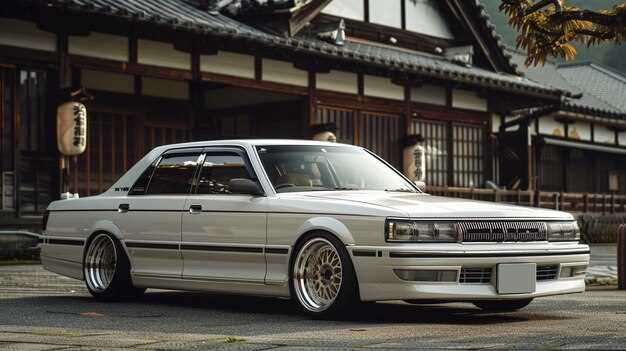
The Subaru 360, often hailed as the quintessential kei car, serves as a benchmark in the history of Japanese automotive engineering. Launched in 1958, this compact vehicle was more than just a mode of transportation; it represented a cultural shift in Japan’s post-war economy and mobility. With its unique combination of affordability, practicality, and distinctive design, the 360 quickly captured the hearts of the Japanese people.
As a kei car, the Subaru 360 was built to meet specific regulations set forth by the Japanese government, allowing owners to benefit from lower taxes and insurance costs. Measuring just 3.3 meters in length and powered by a modest 360cc engine, this vehicle epitomized the essence of compactness and efficiency. The success of the 360 laid the groundwork for the kei car segment, influencing countless subsequent models and manufacturers.
In an era where larger vehicles dominated the global market, the Subaru 360 proved that size isn’t everything. Its charming retro aesthetics, coupled with innovative features for its time, made it a beloved choice for city dwellers navigating the bustling streets of Japan. As we explore the legacy of this remarkable car, it becomes evident that the Subaru 360 is not merely a piece of automotive history but an enduring symbol of Japan’s ingenuity and creativity in the world of kei cars.
Subaru 360: The Pioneer of Japanese Kei Cars

The Subaru 360, introduced in 1958, holds a significant place in automotive history as one of the first kei cars in Japan. Designed to cater to the needs of post-war consumers, this compact vehicle became synonymous with the kei car category, which emphasizes small size and affordability.
Key features of the Subaru 360 include:
- Compact dimensions, measuring just 3.3 meters in length.
- Lightweight construction, allowing for efficient fuel consumption.
- A 360 cc engine, providing adequate power for urban commuting.
- Roomy interior, comfortably accommodating four passengers.
The Subaru 360 was designed with practicality in mind. Its small footprint made it ideal for crowded streets, and its economical engine offered a solution to rising fuel costs. As a pioneering kei car, it directly influenced the future design of similarly compact vehicles.
The Subaru 360 gained popularity not only in Japan but also in international markets. Its unique design and affordability made it a favorite amongst consumers looking for efficient transportation solutions. Over its production run, which lasted until 1971, more than 390,000 units were sold, solidifying its status as an automotive icon.
In summary, the Subaru 360 is celebrated as the pioneer of Japanese kei cars. Its innovative design, combined with practicality and affordability, paved the way for the development of numerous successors in the kei car segment. The legacy of the Subaru 360 continues to influence automotive design and remains a beloved classic among enthusiasts today.
Understanding the Significance of the Subaru 360 in Automotive History
The Subaru 360 holds a unique place in automotive history as one of the first models to embody the kei car concept, which emerged in Japan during the post-war era. Introduced in 1958, this compact vehicle was designed to meet specific regulations that prioritized affordability and practicality, making car ownership accessible to a broader population.
With its small dimensions and economical engine, the Subaru 360 exemplified the kei car philosophy, focusing on efficiency without sacrificing utility. The vehicle’s simple yet functional design contributed to its charm and popularity among consumers in Japan. Its compact size made it an ideal choice for navigating narrow urban streets and offered exceptional maneuverability, which was crucial in densely populated areas.
The significance of the Subaru 360 extends beyond its dimensions; it marked a pivotal moment in Subaru’s evolution as a manufacturer. The car not only established the brand’s presence in the competitive Japanese automobile market but also showcased advanced engineering for its time, including a four-stroke engine which contributed to improved fuel efficiency and reliability.
Moreover, the Subaru 360 cultivated a sense of community and practicality among its users. It became a symbol of affordability and function, allowing families to own a vehicle without incurring significant financial burdens. This made the Subaru 360 a desirable choice for many households, further solidifying the kei car’s importance in Japanese society.
In conclusion, the Subaru 360 is not merely a car; it represents a significant milestone in the history of automotive design and consumer accessibility in Japan. Its impact on the kei car segment has influenced generations of vehicles and continues to resonate in the present day, emphasizing the balance between compactness, efficiency, and affordability in automotive culture.
Key Features and Specifications of the Subaru 360

The Subaru 360 is a quintessential kei car, renowned for its compact size and efficient design. Launched in 1958, it became a symbol of affordable mobility in post-war Japan. One of the standout features of the Subaru 360 is its remarkable fuel efficiency, achieving approximately 60 miles per gallon, which made it an economical choice for consumers.
Under the hood, the Subaru 360 is powered by a small, air-cooled, two-stroke, 356cc engine, producing around 25 horsepower. This lightweight engine allows the car to reach a modest top speed of about 65 mph, making it suitable for city driving and short commutes.
The vehicle’s dimensions are another key aspect of its design. With an overall length of just 3,360 mm (132.3 inches), a width of 1,400 mm (55.1 inches), and a height of 1,430 mm (56.3 inches), the Subaru 360 easily navigates tight urban environments. Its small footprint also contributes to parking ease, making it ideal for crowded cities.
The interior of the Subaru 360 reflects its kei car classification, providing minimalistic but functional space for up to four passengers. The cabin features simple controls and sufficient legroom, designed to maximize comfort in a compact environment. Despite its small size, the trunk space is reasonably sized, allowing for practical everyday use.
Additionally, the Subaru 360’s design features a distinctive rounded shape, characterized by its large windows and compact silhouette. This iconic look not only enhances visibility but also contributes to its charming aesthetic, making it a beloved classic among car enthusiasts.
In summary, the Subaru 360 stands out in the kei car segment due to its efficient engine, compact size, and unique style. These attributes have solidified its place in automotive history as a pioneer of Japanese kei cars.
The Impact of the Subaru 360 on Modern Kei Car Design
The Subaru 360, often heralded as the pioneer of Japanese kei cars, laid the groundwork for an entire segment of compact vehicles that prioritize efficiency, affordability, and functionality. Launched in 1958, this model introduced features that defined the kei class, making it a blueprint for subsequent designs.
One of the most significant impacts of the Subaru 360 on modern kei cars is its compact dimensions and clever space utilization. With a maximum length of just 3.3 meters, the 360 embodied the principles of kei car regulations which promoted smaller, more maneuverable vehicles suitable for urban environments. Today’s kei cars continue to adopt these compact measurements, optimizing interior space while maintaining a small footprint.
Additionally, the Subaru 360 featured a simple and practical design that appealed to a broad demographic. This focus on functionality over extravagance has influenced modern kei car styling, which often emphasizes ease of use and versatility. Vehicles like the Suzuki Alto and Daihatsu Tanto exemplify these enduring design principles, incorporating user-friendly features while preserving a playful aesthetic.
Another important aspect is the Subaru 360’s lightweight construction. Weighing in at approximately 600 kg, its design philosophy centered on efficiency, allowing for lower fuel consumption and reduced emissions. Modern kei cars have taken this lesson to heart, integrating lightweight materials and advanced engineering to enhance performance and sustainability.
| Aspect | Subaru 360 | Modern Kei Cars |
|---|---|---|
| Dimensions | 3.3 meters | Similar small dimensions |
| Design Philosophy | Functionality over extravagance | Ease of use and versatility |
| Weight | Approximately 600 kg | Focus on lightweight materials |
| Fuel Efficiency | High due to compactness | Continued emphasis on efficiency |
Lastly, the cultural significance of the Subaru 360 cannot be overlooked. As one of Japan’s first widely accepted kei cars, it has become an icon of Japanese automotive history and represents the values of practicality and innovation. This cultural legacy remains relevant, as modern kei cars strive to capture the spirit of this beloved model while continuing to evolve in response to contemporary needs and technological advancements.




